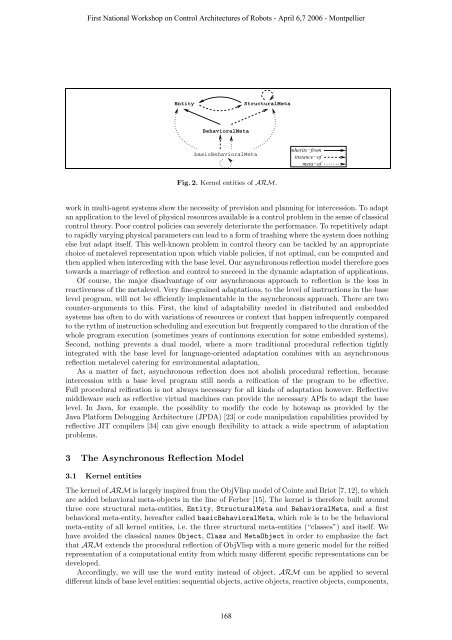Pleading for open modular architectures - Lirmm
Pleading for open modular architectures - Lirmm
Pleading for open modular architectures - Lirmm
Create successful ePaper yourself
Turn your PDF publications into a flip-book with our unique Google optimized e-Paper software.
First National Workshop on Control Architectures of Robots - April 6,7 2006 - Montpellier<br />
Entity StructuralMeta<br />
BehavioralMeta<br />
basicBehavioralMeta<br />
Fig.2. Kernel entities of ARM.<br />
inherits−from<br />
instance−of<br />
meta−of<br />
work in multi-agent systems show the necessity of prevision and planning <strong>for</strong> intercession. To adapt<br />
an application to the level of physical resources available is a control problem in the sense of classical<br />
control theory. Poor control policies can severely deteriorate the per<strong>for</strong>mance. To repetitively adapt<br />
to rapidly varying physical parameters can lead to a <strong>for</strong>m of trashing where the system does nothing<br />
else but adapt itself. This well-known problem in control theory can be tackled by an appropriate<br />
choice of metalevel representation upon which viable policies, if not optimal, can be computed and<br />
then applied when interceding with the base level. Our asynchronous reflection model there<strong>for</strong>e goes<br />
towards a marriage of reflection and control to succeed in the dynamic adaptation of applications.<br />
Of course, the major disadvantage of our asynchronous approach to reflection is the loss in<br />
reactiveness of the metalevel. Very fine-grained adaptations, to the level of instructions in the base<br />
level program, will not be efficiently implementable in the asynchronous approach. There are two<br />
counter-arguments to this. First, the kind of adaptability needed in distributed and embedded<br />
systems has often to do with variations of resources or context that happen infrequently compared<br />
to the rythm of instruction scheduling and execution but frequently compared to the duration of the<br />
whole program execution (sometimes years of continuous execution <strong>for</strong> some embedded systems).<br />
Second, nothing prevents a dual model, where a more traditional procedural reflection tightly<br />
integrated with the base level <strong>for</strong> language-oriented adaptation combines with an asynchronous<br />
reflection metalevel catering <strong>for</strong> environmental adaptation.<br />
As a matter of fact, asynchronous reflection does not abolish procedural reflection, because<br />
intercession with a base level program still needs a reification of the program to be effective.<br />
Full procedural reification is not always necessary <strong>for</strong> all kinds of adaptation however. Reflective<br />
middleware such as reflective virtual machines can provide the necessary APIs to adapt the base<br />
level. In Java, <strong>for</strong> example, the possiblity to modify the code by hotswap as provided by the<br />
Java Plat<strong>for</strong>m Debugging Architecture (JPDA) [23] or code manipulation capabilities provided by<br />
reflective JIT compilers [34] can give enough flexibility to attack a wide spectrum of adaptation<br />
problems.<br />
3 The Asynchronous Reflection Model<br />
3.1 Kernel entities<br />
The kernel of ARM is largely inspired from the ObjVlisp model of Cointe and Briot [7, 12], to which<br />
are added behavioral meta-objects in the line of Ferber [15]. The kernel is there<strong>for</strong>e built around<br />
three core structural meta-entities, Entity, StructuralMeta and BehavioralMeta, and a first<br />
behavioral meta-entity, hereafter called basicBehavioralMeta, which role is to be the behavioral<br />
meta-entity of all kernel entities, i.e. the three structural meta-entities (“classes”) and itself. We<br />
have avoided the classical names Object, Class and MetaObject in order to emphasize the fact<br />
that ARM extends the procedural reflection of ObjVlisp with a more generic model <strong>for</strong> the reified<br />
representation of a computational entity from which many different specific representations can be<br />
developed.<br />
Accordingly, we will use the word entity instead of object. ARM can be applied to several<br />
different kinds of base level entities: sequential objects, active objects, reactive objects, components,<br />
168

















